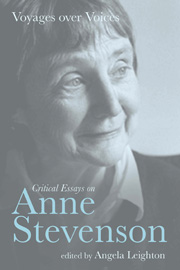Book contents
- Frontmatter
- Contents
- Notes on Contributors
- Acknowledgements
- ‘Making Poetry’
- 1 ‘Voyages over voices’: Introduction
- 2 The Melting Metaphor
- 3 ‘Between us’: Letters and Poems of Stevenson and Bishop
- 4 Mothers, Mirrors, Doubles: Anne Stevenson's Elegies for Sylvia Plath
- 5 Staging Second Thoughts: The Poetry of Anne Stevenson
- 6 ‘Making Poetry’: The Exemplary Anne Stevenson
- 7 ‘A curved adventure’: Romanticism and the Poetry of Anne Stevenson
- 8 The Nature of Anne Stevenson
- 9 Anne Stevenson and the Poetry of Place
- 10 Compacting Time: Anne Stevenson's Poems of Memory
- 11 ‘Not exactly a persona’: Pronouns in Anne Stevenson's Poetry
- 12 ‘To serve a girl on terrible terms’: Anne Stevenson's Writing Selves
- 13 Talking and Singing: Anne Stevenson's Variations on a Rhythmical Theme
- 14 ‘Time will erase’: Anne Stevenson and Elegy
- 15 Observing the Overhearing: The Anne Stevenson Papers in Cambridge University Library
- 16 Bibliography of Anne Stevenson's Published Works
- General Index
- Index of Stevenson's Works
12 - ‘To serve a girl on terrible terms’: Anne Stevenson's Writing Selves
- Frontmatter
- Contents
- Notes on Contributors
- Acknowledgements
- ‘Making Poetry’
- 1 ‘Voyages over voices’: Introduction
- 2 The Melting Metaphor
- 3 ‘Between us’: Letters and Poems of Stevenson and Bishop
- 4 Mothers, Mirrors, Doubles: Anne Stevenson's Elegies for Sylvia Plath
- 5 Staging Second Thoughts: The Poetry of Anne Stevenson
- 6 ‘Making Poetry’: The Exemplary Anne Stevenson
- 7 ‘A curved adventure’: Romanticism and the Poetry of Anne Stevenson
- 8 The Nature of Anne Stevenson
- 9 Anne Stevenson and the Poetry of Place
- 10 Compacting Time: Anne Stevenson's Poems of Memory
- 11 ‘Not exactly a persona’: Pronouns in Anne Stevenson's Poetry
- 12 ‘To serve a girl on terrible terms’: Anne Stevenson's Writing Selves
- 13 Talking and Singing: Anne Stevenson's Variations on a Rhythmical Theme
- 14 ‘Time will erase’: Anne Stevenson and Elegy
- 15 Observing the Overhearing: The Anne Stevenson Papers in Cambridge University Library
- 16 Bibliography of Anne Stevenson's Published Works
- General Index
- Index of Stevenson's Works
Summary
What does it mean when a poet refers to poetry as ‘the shared comedy of the worst blessed’? Does it mean that poets make up a select community of the tragic-comic? Are they the ‘worst blessed’ because they are the worst kind of people that could be blessed, or because their gift is in fact the worst kind of blessing that could be received? Anne Stevenson makes this statement in ‘Making Poetry’ (reproduced here on p. 1), which is the first in her own thematic arrangement of poems written between 1955 and 2005. Heading, as it does, a section entitled ‘Prologue’, it is tempting to read this poem as a kind of prefatory manifesto to the collected work, and a playfully ambivalent one. It implies that all that is to come in the book is a kind of happy contradiction, shared between poet and reader, and that poetry is, at the end of the day, worthy of diversion, praise, derision, suspicion, fascination and love – but certainly not of veneration. In this way it gathers together many of the ideas about writing that are dramatised throughout Stevenson's work, where poetry is characterised as the playful collaboration of plural writing selves.
In this essay I want to concentrate on this plurality, as it is played out in poetic treatments of two recurring preoccupations: the self in time, and the self in language. And the word ‘playing’ is important, because Stevenson knowingly ‘plays’ in her poetry in a number of ways. There is her ‘playing’ of poetry as a type of illuminating game, as the adoption of provisional systems and selves in the face of a mechanised and impersonal reality. There is her ‘playing’ of poetry as a kind of instrument. Here the poet is a ‘player’ who draws out and creates meaning and order through musicality in language – her instrument – but who is also, in another sense, herself the played, the instrument of poetry. The poet, then, is doubly, paradoxically, instrumental.
- Type
- Chapter
- Information
- Voyages over VoicesCritical Essays on Anne Stevenson, pp. 173 - 190Publisher: Liverpool University PressPrint publication year: 2010

